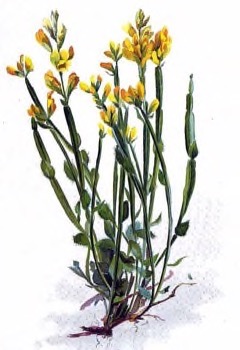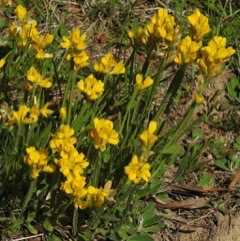 |
|
edibleplants.org |
 |
| Robert Flogaus-Faust wikimedia.org |
Translate this page:
Summary
Physical Characteristics

 Genista sagittalis is a deciduous Shrub growing to 0.3 m (1ft) by 0.9 m (3ft in) at a medium rate.
Genista sagittalis is a deciduous Shrub growing to 0.3 m (1ft) by 0.9 m (3ft in) at a medium rate.
See above for USDA hardiness. It is hardy to UK zone 4.
It can fix Nitrogen.
It is noted for attracting wildlife.
Suitable for: light (sandy) and medium (loamy) soils, prefers well-drained soil and can grow in nutritionally poor soil. Suitable pH: mildly acid, neutral and basic (mildly alkaline) soils and can grow in very alkaline soils.
It can grow in semi-shade (light woodland) or no shade. It prefers dry or moist soil and can tolerate drought.
UK Hardiness Map
US Hardiness Map
Synonyms
Chamaespartium sagittale (L.) P.E.Gibbs. Chamaespartium sagittale (L.) P. Gibbs. Cytisus sagittalis (L.) Koch. G. delphinensis Verl. Genistella sagittalis (L.) Gams. Genistella sagittalis subsp. delphinensis (Verl.) P.Fourn. Genistella sagittalis subsp. sagittalis. Pterospartum sagittale (L.) Willk.
Plant Habitats
Edible Uses
References More on Edible Uses
Medicinal Uses
Plants For A Future can not take any responsibility for any adverse effects from the use of plants. Always seek advice from a professional before using a plant medicinally.
None known
References More on Medicinal Uses
The Bookshop: Edible Plant Books
Our Latest books on Perennial Plants For Food Forests and Permaculture Gardens in paperback or digital formats.

Edible Tropical Plants
Food Forest Plants for Hotter Conditions: 250+ Plants For Tropical Food Forests & Permaculture Gardens.
More

Edible Temperate Plants
Plants for Your Food Forest: 500 Plants for Temperate Food Forests & Permaculture Gardens.
More

More Books
PFAF have eight books available in paperback and digital formats. Browse the shop for more information.
Shop Now
Other Uses
A good high density groundcover. Nitrogen Fixer. Location: Border, Ground Cover, Mass Planting, Rock Garden, Wildlife Garden, Woodland Garden. A very hardy, mat-forming plant for the rock garden. Invertebrates shelter: beneficial for insects and other arthropods. Nectary: provides nectar or pollen for beneficial insects [1-2].
Special Uses
Food Forest Ground Cover Nitrogen Fixer
References More on Other Uses
Cultivation details
A prostrate, very hardy, sometimes spiny, deciduous shrub or small tree that forms a wide mat of flattened, upright stems. It requires full sun and a very well-drained soil. Soil: Sand, Chalk, Loam. In the wild, it often grow on limestone but in cultivation, it is not too particular about soil pH as long as it is not too acidic. pH: Acid, Alkaline, Neutral. Exposure: Exposed or Sheltered. Upper elevation limit:2,700 metres. Lower elevation limit: 0 metres. Blooming Period: April in the south to July in the north. For polyculture design as well as the above-ground architecture (form - tree, shrub etc. and size shown above) information on the habit and root pattern is also useful and given here if available. A clumping mat former. Forming a dense prostrate carpet with a limited spread [1-2].
References Carbon Farming Information and Carbon Sequestration Information
Temperature Converter
Type a value in the Celsius field to convert the value to Fahrenheit:
Fahrenheit:
The PFAF Bookshop
Plants For A Future have a number of books available in paperback and digital form. Book titles include Edible Plants, Edible Perennials, Edible Trees,Edible Shrubs, Woodland Gardening, and Temperate Food Forest Plants. Our new book is Food Forest Plants For Hotter Conditions (Tropical and Sub-Tropical).
Shop Now
Plant Propagation
Seed: Easy. Cover seed and germinate at 55-65F/13-18C. Chipping and soaking may aid germination. Do not transplant. Cuttings taken in summer, or by simple layering. Tip cuttings about 3-6 cm may be taken in mid-summer and rooted in a mist chamber or shaded frame.
Other Names
If available other names are mentioned here
Winged broom, arrow-jointed broom, hare's foot greenweed
Native Range
EUROPE: Czechoslovakia (Czech Republic and Slovakia), Austria, Belgium, Switzerland, Germany, Hungary, Former Yugoslavia, Albania, Bulgaria, Greece, Italy, Romania, Spain, France,
Weed Potential
Right plant wrong place. We are currently updating this section.
Please note that a plant may be invasive in one area but may not in your area so it's worth checking.
None Known
Conservation Status
IUCN Red List of Threatened Plants Status : Least Concern

Growth: S = slow M = medium F = fast. Soil: L = light (sandy) M = medium H = heavy (clay). pH: A = acid N = neutral B = basic (alkaline). Shade: F = full shade S = semi-shade N = no shade. Moisture: D = dry M = Moist We = wet Wa = water.
Now available:
Food Forest Plants for Mediterranean Conditions
350+ Perennial Plants For Mediterranean and Drier Food Forests and Permaculture Gardens.
[Paperback and eBook]
This is the third in Plants For A Future's series of plant guides for food forests tailored to
specific climate zones. Following volumes on temperate and tropical ecosystems, this book focuses
on species suited to Mediterranean conditions—regions with hot, dry summers and cool, wet winters,
often facing the added challenge of climate change.
Read More
Expert comment
Author
L.
Botanical References
Links / References
For a list of references used on this page please go here
Readers comment
| Add a comment |
|
If you have important information about this plant that may help other users please add a comment or link below. Only comments or links that are felt to be directly relevant to a plant will be included. If you think a comment/link or information contained on this page is inaccurate or misleading we would welcome your feedback at [email protected]. If you have questions about a plant please use the Forum on this website as we do not have the resources to answer questions ourselves.
* Please note: the comments by website users are not necessarily those held by PFAF and may give misleading or inaccurate information.
To leave a comment please Register or login here All comments need to be approved so will not appear immediately.
|
Subject : Genista sagittalis
|
|
|
|